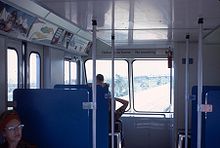- Expo Express
-
Expo Express Legend
Cité du Havre/Place d’Accueil 
Habitat 67 
Saint Lawrence River Île Sainte-Hélène 
Le Moyne Channel Île Notre Dame L’homme et l’agriculture 
Le Moyne Channel La Ronde 
Maintenance centre The Expo Express was a rapid transit system consisting of five stations and a 5.7-kilometre route. Built for Montreal’s Expo 67 and costing around $18 million, the trains carried 1,000 passengers each and ran approximately every five minutes.
After Expo 67, the cars were sold to the City of Montreal and service ran for four more years on a shortened route. In 1972 the service was abandoned.
Contents
Vehicles
Not to be confused with the Minirail monorail which ran within the perimeters of the Expo Site, the Expo Express used standard railway technology, with two running rails and a third electrified rail identical to those of the Toronto subway. It ran from April 1967 to October 1972 (the last year Terre-des-Hommes Notre-Dame island was opened to the public) and was then mothballed and stored on Ile Notre Dame with a few trainsets in a shed adjacent to the LaRonde amusement park until the summer of 1979, when they were moved out to the Port of Montréal by building a temporary track where the line to Cité du Havre used to be.
After several abortive schemes to re-use the cars, they were moved from the Port of Montreal to a storage facility in Les Cèdres (Québec) in the late 1980s, and were finally cut up for scrap in the mid 1990s.
The trains used were a modified version of the Hawker Siddeley H-series used by the Toronto Transit Commission with one fewer door on each side, and streamlined ends.
The Expo Express was the first fully automated rapid transit system in North America, utilizing an Automatic Train Operation (ATO) system based on audio frequency track circuits furnished by the Union Switch & Signal division of Westinghouse Air Brake Company (WABCO). This fact, however, was not widely publicized during the fair, as it was felt the public would not readily board a train controlled entirely by a computer. Operators from Montreal's transit union were placed in cabs at the front and given mundane tasks such as opening and closing the doors of the train to reduce boredom. This actually resulted in a minor incident during the fair, at La Ronde station. The conductor had pressed the button to close the doors and proceed, but his train had already sensed an oncoming express from Ile Notre Dame and automatically delayed the go command to let it roll in. In the meantime, the driver realized he had forgotten his lunch. However, he could not exit though the passenger doors because his train was in a "wait" state and would not allow the doors to open. Instead, he crawled through the small cab window. By the time he had fetched his lunch, however, the oncoming train had pulled in and his train had taken off on its own. It crossed the bridge over the Le Moyne Channel, proceeded along the seaway, and came to a smooth stop at Ile Notre Dame station where an Expo official was waiting. This person crawled back through the cab window and pressed the button to open the doors and let the passengers disembark.
- Type: H1 variant
- Fleet: 48 cars
- Configuration: 8 sets of 6 cars
- Operator: City of Montréal
- Builder: Hawker Siddeley Canada Limited, Fort William, Ontario
Although the Expo Express used traditional steel-wheeled trains, Montréal's contemporary (and permanent) Métro system did not. Rubber-tired trains based on technology developed by the Paris Métro, were selected instead: the Canadian Vickers/Bombardier Transportation MR-63 and MR-73 trains.
The line
The line started at the Place d’Accueil in Cité du Havre
- Gare Cité du Havre / Place d’Accueil, closed in 1968.
- Gare Habitat 67 (outbound only), closed in 1968.
- Gare Île Sainte-Hélène
- Gare Île Notre Dame
- Gare L’homme et l’agriculture (inbound only), added in 1968.
- Gare La Ronde
The line was double-track throughout, except for a single-track section at Place d’Accueil, where people exited on one side of the train and boarded on the other.
When the terminus was brought back to Île Sainte-Hélène in 1968, it was single-tracked as well.
The line was dismantled north of Île-Notre-Dame in 1974 for the construction of the Olympic basin; rolling stock was moved between Île-Notre-Dame and Île-Sainte-Hélène and stored there until 1979.
Maintenance facilities were located northwest of La Ronde station.
See also
References
External links
Categories:- Société de transport de Montréal
- Rapid transit in Canada
- Transportation in Montreal
- Expo 67
Wikimedia Foundation. 2010.





